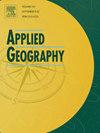Developing a taxonomy framework for assessing human capital provision: A case study of Southern Italian municipalities
IF 4
2区 地球科学
Q1 GEOGRAPHY
引用次数: 0
Abstract
The decline of rural areas emerges as a central aspect of European and national policies. Decline manifests itself in distinct forms, resulting from the interaction among exogenous and local factors. Understanding the different socio-economic trends and tangible and intangible conditions of rural areas, defined as the intra-rural divide, is central to the definition of priorities of public policies. Within this framework, the proposed study focuses on the notion of Territorial Capital (TC) with a particular focus on Human Capital (HC) as a conceptual frame for investigating the intra-rural divide. Different unsupervised learning methods have been employed to identify clusters of similar administrative units in terms of HC provision using a set of 12 input indicators, enabling a deeper understanding of the intra-rural divide. The study area consists of six southern Italian regions, specifically chosen due to their pronounced disparities. The present work contributes to the discipline of regional and urban studies by developing a novel taxonomy framework specifically for assessing HC disparities at a detailed local level, thereby making the concept of the intra-rural divide measurable and analyzable and enabling the definition of targeted policies respondent to individual areas’ needs.
开发评估人力资本提供的分类框架:意大利南部城市的案例研究
农村地区的衰落成为欧洲和国家政策的一个中心方面。衰退以不同的形式表现出来,是外生因素和局部因素相互作用的结果。了解农村地区不同的社会经济趋势以及有形和无形的条件(定义为农村内部差距)是确定公共政策优先事项的核心。在这一框架内,本研究将重点放在领土资本(TC)的概念上,特别关注人力资本(HC)作为调查农村内部鸿沟的概念框架。采用了不同的无监督学习方法,使用一组12个输入指标来识别HC提供方面类似行政单位的集群,从而能够更深入地了解农村内部的鸿沟。研究区域包括六个意大利南部地区,特别选择,因为他们明显的差异。本研究为区域和城市研究学科做出了贡献,开发了一种新的分类框架,专门用于在详细的地方一级评估卫生保健差异,从而使农村内部鸿沟的概念可测量和分析,并使有针对性的政策定义符合个别地区的需要。
本文章由计算机程序翻译,如有差异,请以英文原文为准。
求助全文
约1分钟内获得全文
求助全文
来源期刊

Applied Geography
GEOGRAPHY-
CiteScore
8.00
自引率
2.00%
发文量
134
期刊介绍:
Applied Geography is a journal devoted to the publication of research which utilizes geographic approaches (human, physical, nature-society and GIScience) to resolve human problems that have a spatial dimension. These problems may be related to the assessment, management and allocation of the world physical and/or human resources. The underlying rationale of the journal is that only through a clear understanding of the relevant societal, physical, and coupled natural-humans systems can we resolve such problems. Papers are invited on any theme involving the application of geographical theory and methodology in the resolution of human problems.
 求助内容:
求助内容: 应助结果提醒方式:
应助结果提醒方式:


